A01771 Summary:
| BILL NO | A01771 |
| SAME AS | No Same As |
| SPONSOR | Fitzpatrick (MS) |
| COSPNSR | |
| MLTSPNSR | Manktelow |
| Amd §3604, Ed L | |
| Provides that no school district shall be eligible to receive the full apportionment of state aid to which it is entitled if evidence is found by the state comptroller when an audit is conducted and such audit finds that a district has inappropriate excess of their unexpended surplus funds and such school district did not reduce the school tax levy in a proportion equal to the excess of four percent of the current year school budget. | |
A01771 Actions:
| BILL NO | A01771 | |||||||||||||||||||||||||||||||||||||||||||||||||
| 01/14/2025 | referred to education | |||||||||||||||||||||||||||||||||||||||||||||||||
A01771 Memo:
Go to topNEW YORK STATE ASSEMBLY
MEMORANDUM IN SUPPORT OF LEGISLATION
submitted in accordance with Assembly Rule III, Sec 1(f)
TITLE OF BILL: An act to amend the education law, in relation to school district state aid eligibility PURPOSE OR GENERAL IDEA OF BILL: Authorizes the State Education Department to withhold State Aid from schools that have an undesignated fund balance that exceeds the statuto- ry four percent limit. SUMMARY OF PROVISIONS: Section 1 of this bills adds a new subdivision 8-a to section 3604 of the Education Law and would authorize the State Education Department to withhold a portion of State Aid when an audit conducted by the State Comptroller finds evidence that a school has an undesignated fund balance that exceeds the statutory limit of four percent. Section 2. Provides the effect date. DIFFERENCE BETWEEN ORIGINAL AND AMENDED VERSION (IF APPLICABLE): JUSTIFICATION: A good practice of fiscal management is to accumulate a reasonable surplus of unrestricted funds that allows school districts to stabilize their finances by providing "rainy day funds" for any unexpected cash flow shortages. However, there must be .a limit to how much a school district can have in unrestricted funds to avoid overtaxing residents. State law requires school districts to apply any unrestricted funds in an amount that is greater than four percent of the current school year budget in the calculation of the next year's school tax levy. The State Comptroller has found that an increasing number of districts across the State have an inappropriate amount of unrestricted funds that exceed the four percent statutory limit. However, the Comptroller has no way to penalize districts that do this. As property taxes continue to rise, school districts must be held accountable in using unrestricted funds to provide relief to property taxpayers. In cases where it is found that districts are not using these funds to provide property tax relief, the State must step in and reduce State Aid to the district by the amount the district has in excess of the legal limit. PRIOR LEGISLATIVE HISTORY: 2024 - A4299 - Referred to Education Committee 2022 - A5610 - Referred to Education Committee 2020 - A5371 - Held in Governmental Operations FISCAL IMPLICATIONS FOR STATE AND LOCAL GOVERNMENTS: Potential savings to the State. EFFECTIVE DATE: This act shall take effect immediately.
